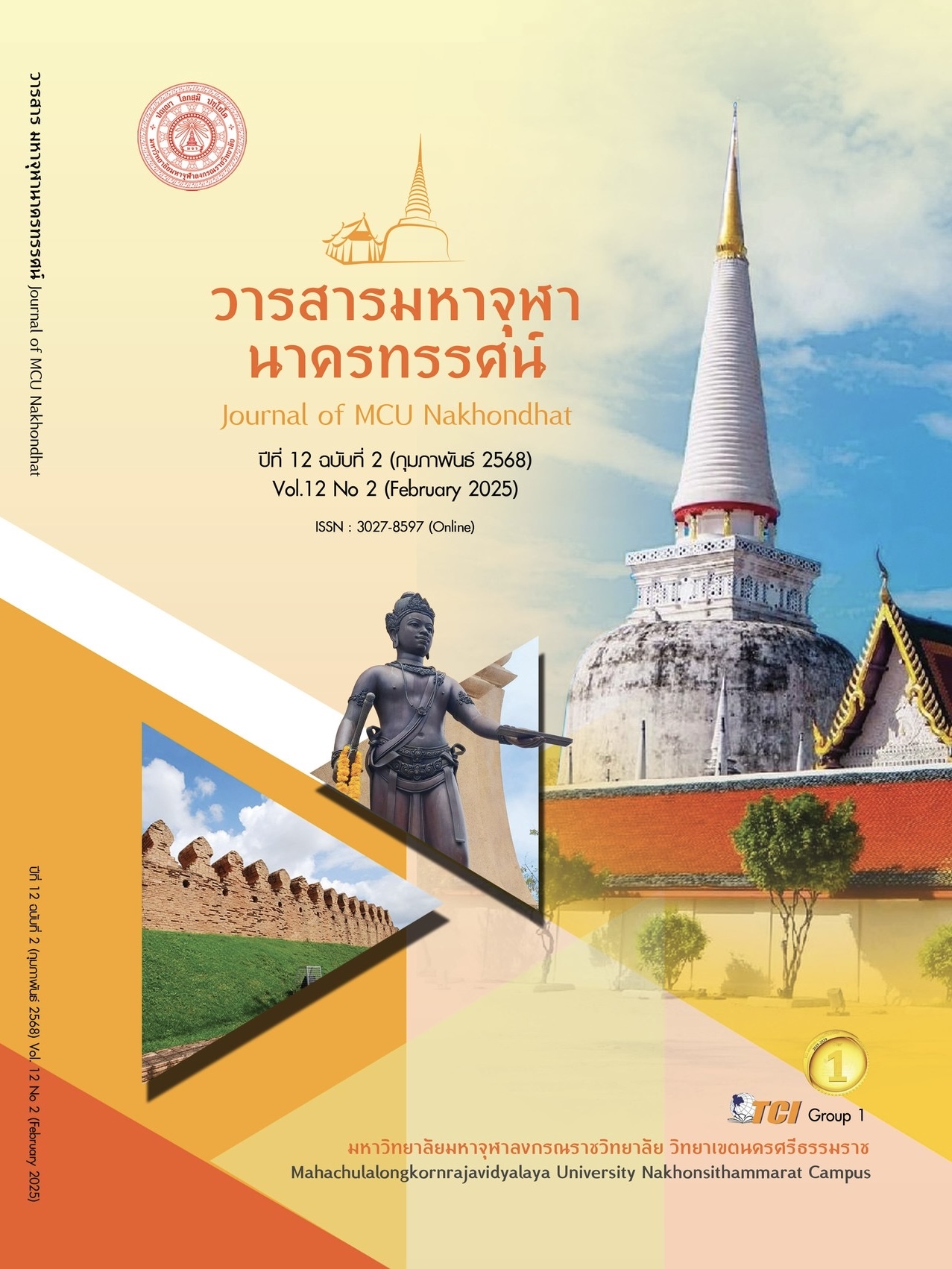แนวทางการฟื้นฟูภาวะถดถอยทางการเรียนรู้ของผู้เรียน สังกัดสำนักงานเขตพื้นที่การศึกษาประถมศึกษานครพนม เขต 1
Main Article Content
บทคัดย่อ
การวิจัยนี้มีวัตถุประสงค์เพื่อ 1) ศึกษาสภาพปัจจุบันและสภาพที่พึงประสงค์ของภาวะถดถอยทางการเรียนรู้ของผู้เรียน 2) ประเมินความต้องการจำเป็น 3) พัฒนาแนวทางการฟื้นฟู และ 4) ประเมินความเหมาะสมและความเป็นไปได้ของแนวทางดังกล่าว กลุ่มตัวอย่างประกอบด้วยผู้บริหารและครู 272 คน ที่สุ่มเลือกแบบชั้นภูมิใช้ระเบียบวิธีการวิจัยและพัฒนา แบ่งเป็น 2 ระยะ คือ ระยะที่ 1 ใช้เครื่องมือวิจัย คือ แบบสอบถาม ระยะที่ 2 ใช้เครื่องมือวิจัย ได้แก่ แบบสัมภาษณ์ และแบบประเมินแนวทางพัฒนา สถิติที่ใช้วิเคราะห์ข้อมูล ได้แก่ ร้อยละ ค่าเฉลี่ย ส่วนเบี่ยงเบนมาตรฐาน และดัชนีการจัดลำดับความสำคัญของความต้องการจำเป็นแบบปรับปรุง ผลการวิจัยพบว่า สภาพปัจจุบันของภาวะถดถอยทางการเรียนรู้อยู่ในระดับมาก ( = 3.66) ขณะที่สภาพที่พึงประสงค์อยู่ในระดับมากที่สุด (
= 4.59) โดยด้านสุขภาพจิตของผู้เรียนเป็นความต้องการจำเป็นสูงสุด (PNI Modified = 0.258) แนวทางฟื้นฟูประกอบด้วย 3 ด้านหลัก ได้แก่ 1) การพัฒนาโอกาสเข้าถึงการศึกษา การสนับสนุนอุปกรณ์และอินเทอร์เน็ตฟรี และสร้างความร่วมมือกับชุมชนเพื่อเสริมโอกาสการศึกษา 2) การยกระดับคุณภาพการเรียนรู้ ปรับหลักสูตรและวิธีวัดผล ส่งเสริมการเรียนรู้แบบบูรณาการ และใช้เทคโนโลยีเสริมการเรียนรู้ตามความสนใจ และ 3) การสร้างสภาพแวดล้อมเอื้อต่อการเรียนรู้ การส่งเสริมสุขภาพกาย จิตใจ และฝึกทักษะการจัดการอารมณ์ พร้อมอบรมครูและผู้ปกครองเกี่ยวกับปัญหาสุขภาพจิตของนักเรียน การประเมินแนวทาง พบว่า มีความเหมาะสมและเป็นไปได้ในระดับมากที่สุด งานวิจัยนี้เน้นถึงความสำคัญของการพัฒนาแนวทางฟื้นฟูภาวะถดถอยทางการเรียนรู้ โดยมีการสนับสนุนจากทุกภาคส่วนและการใช้ทรัพยากรอย่างมีประสิทธิภาพ เพื่อสร้างสภาพแวดล้อมที่เอื้อต่อการเรียนรู้และพัฒนาศักยภาพของผู้เรียนอย่างยั่งยืน
Article Details

อนุญาตภายใต้เงื่อนไข Creative Commons Attribution-NonCommercial-NoDerivatives 4.0 International License.
เอกสารอ้างอิง
กองทุนเพื่อความเสมอภาคทางการศึกษา. (2565). จาก Learning Loss สู่ Learning Recovery ฟื้นฟูภาวะถดถอยทางการศึกษา ในสถานการณ์ที่เปลี่ยนแปลงหลังโควิด - 19. เรียกใช้เมื่อ 18 พฤษภาคม 2567 จาก https://www.eef.or.th/news-learning-loss-learning-recovery-081122/
ขวัญธารา พุ่มพฤกษ์ และคณะ. (2566). การลดภาวะถดถอยทางการเรียนรู้ของนักเรียนไทยจากการเรียนการสอนออนไลน์ในสถานการณ์การแพร่ระบาดของเชื้อไวรัสโควิด - 19 โดยใช้รูปแบบการวิจัยเชิงปฏิบัติการในชั้นเรียน. วารสารครุศาสตร์ มหาวิทยาลัยราชภัฏนครศรีธรรมราช, 2(1), 13-23.
นฤมล กิจรุ่งเรือง และคณะ. (2565). แนวทางการส่งเสริมและแก้ไขปัญหาภาวะถดถอยทางการเรียนรู้ของนักเรียนที่เหมาะสมกับโรงเรียนในสังกัดเทศบาลนครนนทบุรี. ใน การประชุมวิชาการระดับชาติครั้งที่ 19. มหาวิทยาลัยเกษตรศาสตร์วิทยาเขตกำแพงแสน.
บุญชม ศรีสะอาด. (2560). การวิจัยเบื้องต้น ฉบับปรับปรุงใหม่. (พิมพ์ครั้งที่ 10). กรุงเทพมหานคร: สุวีริยาสาสน์.
บุญเลี้ยง ทุมทอง. (2565). สภาวะการถดถอยทางการเรียนรู้ของผู้เรียนระดับการศึกษาขั้นพื้นฐานในประเทศไทยช่วงสถานการณ์โควิด - 19: สภาพการณ์ สาเหตุ และแนวทางการพัฒนาคุณภาพการเรียนรู้. วารสาร มจร สังคมศาสตร์ปริทรรศน์, 13(3), 453-472.
ปรัชญา ธงพานิช และคณะ. (2566). การพัฒนาตัวบ่งชี้ภาวะผู้นำเชิงนวัตกรรมของผู้บริหารสถานศึกษาสังกัดสำนักงานเขตพื้นที่การศึกษามัธยมศึกษาในอนุภูมิภาคลุ่มแม่น้ำโขง. Journal of Roi Kaensarn Academi, 8(9), 560-576.
พัทธ์ธีรา อุยนันทพิทักษ์ และคณะ. (2567). การแก้ไขปัญหาภาวะถดถอยทางการเรียนรู้ของผู้เรียนภายในสถานศึกษา: กรณีโรงเรียนวัดไทรทอง สังกัดสำนักงานเขตพื้นที่การศึกษาประถมศึกษาตราด. วารสารปราชญ์ประชาคม, 2(2), 26-39.
รจิต พุ่มพฤกษ์ และทวีศิลป์ กุลนภาดล. (2566). การศึกษาแนวทางเพื่อฟื้นฟูภาวะถดถอยทางการเรียนรู้ของนักเรียนระดับมัธยมศึกษาภายหลังสถานการณ์การแพร่ระบาดของเชื้อไวรัสโควิด - 19 ในภาวะปกติถัดไป. วารสารพุทธศาสตร์ มจร อุบลราชธานี, 6(2), 941-958.
รุ่งทิวา สุขศรีพานิช และคณะ. (2567). แนวทางการจัดการเรียนการสอนภาษาอังกฤษเพื่อฟื้นฟูภาวะถดถอยทางการเรียนรู้ (Learning loss) สำหรับโรงเรียนขนาดเล็ก. Journal of Roi Kaensarn Academi, 9(3), 518-531.
สำนักงานเขตพื้นที่การศึกษาประถมศึกษานครพนม เขต 1. (2567). ข้อมูลสารสนเทศทางการศึกษา. เรียกใช้เมื่อ 18 พฤษภาคม 2567 จาก https://www.nkpedu1.go.th/information.
สำนักงานเลขาธิการสภาการศึกษา. (2565). มาตรการฟื้นฟูภาวะถดถอยทางการเรียนรู้. กรุงเทพมหานคร: เอส บี เค การพิมพ์.
อิทธิพัทธ์ สุวทันพรกูล และคณะ. (2565). การศึกษาภาวะถดถอยทางการเรียนรู้ของผู้เรียนระดับการศึกษาขั้นพื้นฐานในสถานการณ์โควิด - 19: สภาพการณ์ บทเรียน และแนวทางการพัฒนาคุณภาพการเรียนรู้. ใน รายงานการวิจัย. มหาวิทยาลัยศรีนครินทรวิโรฒ.
Harmey, S. & Moss, G. (2023). Learning disruption or learning loss: using evidence from unplanned closures to inform returning to school after COVID-19. Educational Review, 75(4), 637-656.


